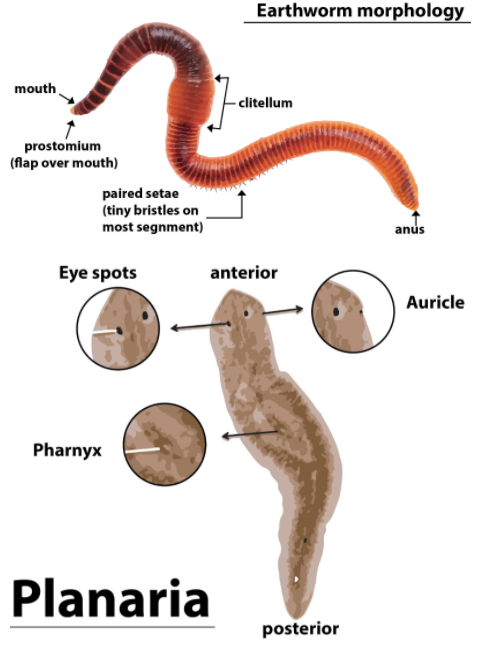
In contrast to annelids, the Platyhelminthes show
(a) Radial symmetry
(b) Presence of pseudocoel
(c) Bilateral symmetry
(d) Absence of body cavity
Answer
459k+ views
Hint: Both the annelids and Platyhelminthes are mostly aquatic and are equipped with well-developed musculature for support and movement. But the annelids have a special organization of its wall layers which gives it an edge over Platyhelminthes.
Complete answer:
Phylum Annelida is a large phylum. Annelids are mostly known as ringworms or segmented worms. They are coelomate (body cavity) and triploblastic. They possess a bilaterally symmetrical body organization wherein a plane passing through their center divides them into two equal right and left halves. The Platyhelminthes are also bilaterally symmetrical, triploblastic true multicellular organizations with a dorso-ventrally flattened body. They do not possess a body cavity and thus are acoelomate, unlike annelids that possess a true coelom and thus are coelomate.
Additional Information: -Annelids are metamerically segmented animals living in freshwater, seawater, or moist soil. Their digestive tract is also complete. Their characteristic feature is the external segmentation of their body into ring-like grooves called annuli.
-Flatworms are mostly parasites and thus they are devoid of the alimentary canal. They usually absorb the digested food of their host through their general body surface. E.g. Taenia solium. A blind sac body plan is exhibited by them.
-Phylum Ascehelminthes are the only phylum in the animal kingdom that are characterized by the presence of a false body cavity or pseudocoelom that is not lined by epithelium.
-Cnidarians are radially symmetrical, diploblastic, and multicellular organisms with a tissue grade of organization. They are aquatic with habitats ranging from freshwater to marine. They may exist in solitary forms or forming colonies. They may be free-swimming or sedentary. E.g. Hydra.
So, the correct answer is ‘Absence of body cavity.’
Note: In a blind sac body plan, an animal has a single pore which serves the dual function of ingestion as well egestion. That means food enters through an opening into a single cavity and after digestion, the undigested food is passed out from the same opening. Along with Platyhelminthes, Cnidarians also have a blind sac body plan.

Complete answer:
Phylum Annelida is a large phylum. Annelids are mostly known as ringworms or segmented worms. They are coelomate (body cavity) and triploblastic. They possess a bilaterally symmetrical body organization wherein a plane passing through their center divides them into two equal right and left halves. The Platyhelminthes are also bilaterally symmetrical, triploblastic true multicellular organizations with a dorso-ventrally flattened body. They do not possess a body cavity and thus are acoelomate, unlike annelids that possess a true coelom and thus are coelomate.
Additional Information: -Annelids are metamerically segmented animals living in freshwater, seawater, or moist soil. Their digestive tract is also complete. Their characteristic feature is the external segmentation of their body into ring-like grooves called annuli.
-Flatworms are mostly parasites and thus they are devoid of the alimentary canal. They usually absorb the digested food of their host through their general body surface. E.g. Taenia solium. A blind sac body plan is exhibited by them.
-Phylum Ascehelminthes are the only phylum in the animal kingdom that are characterized by the presence of a false body cavity or pseudocoelom that is not lined by epithelium.
-Cnidarians are radially symmetrical, diploblastic, and multicellular organisms with a tissue grade of organization. They are aquatic with habitats ranging from freshwater to marine. They may exist in solitary forms or forming colonies. They may be free-swimming or sedentary. E.g. Hydra.
So, the correct answer is ‘Absence of body cavity.’
Note: In a blind sac body plan, an animal has a single pore which serves the dual function of ingestion as well egestion. That means food enters through an opening into a single cavity and after digestion, the undigested food is passed out from the same opening. Along with Platyhelminthes, Cnidarians also have a blind sac body plan.

Recently Updated Pages
How to find how many moles are in an ion I am given class 11 chemistry CBSE

Class 11 Question and Answer - Your Ultimate Solutions Guide

Identify how many lines of symmetry drawn are there class 8 maths CBSE

State true or false If two lines intersect and if one class 8 maths CBSE

Tina had 20m 5cm long cloth She cuts 4m 50cm lengt-class-8-maths-CBSE

Which sentence is punctuated correctly A Always ask class 8 english CBSE

Trending doubts
What problem did Carter face when he reached the mummy class 11 english CBSE

What organs are located on the left side of your body class 11 biology CBSE

Proton was discovered by A Thomson B Rutherford C Chadwick class 11 chemistry CBSE

Petromyzon belongs to class A Osteichthyes B Chondrichthyes class 11 biology CBSE

State the laws of reflection of light

Can anyone list 10 advantages and disadvantages of friction




